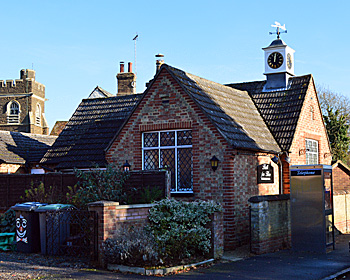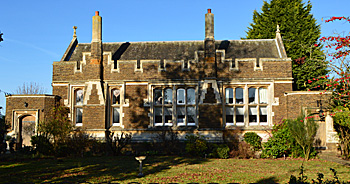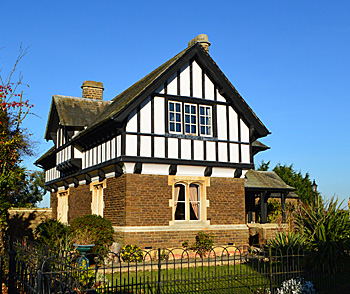Steppingley School

The Village Hall (the old school) December 2016
The first school at Steppingley was built at the expense of the Duke of Bedford. It is now the village hall on the corner of Rectory Road. The first Education Act was passed in 1870 (more correctly it was known as the Elementary Education Act). It was a milestone in the provision of education in Britain demonstrating central government's unequivocal support for education of all classes across the country. It also sought to secularise education by allowing the creation of School Boards. These were groups of representatives, elected by the local ratepayers and the Board had the powers to raise funds to form a local rate to support local education, build and run schools, pay the fees of the poorest children, make local school attendance compulsory between the ages of 5 and 13 and could even support local church schools, though in practice they replaced them, turning them into Board run schools (known as Board Schools). Naturally, and luckily for local historians, the Act required a questionnaire of local schools in 1870. The return for Steppingley tells us that the Church of England school had accommodation for fifty children. Accommodation for a further eighteen was required.
The first school log book [SDSteppingley1] dated from 1868 to 1902. Various entries show how difficult to enforce school attendance was:
- 25 September 1868: Very wet day, consequently some of the babies absent.
- 20 October 1868: School thin, some of the absentees gone to Millbrook Feast.
- 2 November 1868: Three girls absent to pick up acorns
- 10 June 1869: Some children late again, through having to carry breakfast to their fathers
- 24 September 1869: Several children away in the afternoon to pick up potatoes
- 25 November 1869: Three boys absent bird-keeping
- 6 April 1870: Four boys absent - all gone to work for a few days.
- 21 March 1871: Julia Scott left to plait
- 27 June 1873: Four boys have gone to work during hay-making.
- 12 September 1873: The attendance has been low owing to the gleaning not being over.
The subjects taught were varied. They learned the usual; subjects such as reading, writing and arithmetic. They also had lessons on geography, scripture, needlework and poetry and were told all about the Prayer Book.
Sometimes the children were naughty and had to be punished:
- 2 November 1868: Children were not punctual in the morning, kept all in who were not present at Prayers.
- 28 January 1869: Sent to fetch Henry Warner and P Scott to school having seen them playing in the street.
- 3 February 1869: Punished some children for throwing stones in the playground.
- 3 March 1869: Henry Smith played truant in the afternoon.
- 11 April 1869: Kept G Askew in for breaking window.
- 15 April 1869: Sent for three girls in the afternoon who intended playing truant.
- 28 February 1871: The Policeman to threaten boys for throwing stones.
- 17 November 1875: Punished J White and C Battams for taking matches from school cupboard and making a fire on Wednesday afternoon.
Some of the entries clearly belonged to the era before the all-transcending power of Health and Safety
- 3 November 1869: Several of the first class were unable to work on account of bad fingers [no doubt chilblains, the school would have been unheated and very cold at times].
- 7 July 1870: Very hot; sent babies under the shed.
- November 1874: Allowed children to sit around the fire on Thursday and Friday morning as several cried from cold.
Steppingley School Board came into being on 21st March 1874 with the purpose of building a bigger school. This new Steppingley Board School was built at the expense of the Duke of Bedford in 1878. The duke then hired the building to the School Board for the nominal sum of ten shillings per annum. He also built the school house for the teacher and leased this out for £5 per annum. The first day in the new school was 17th June 1878. The age of the children ranged between two and twelve years.

The former school December 2016
The school opening was reported by the Bedfordshire Times on 3rd August 1878: “…the Steppingley Schools are such a gem that both their merits and the idea that produced them should be widely appreciated. They stand on open ground near the church, small and massive, of a style that was seen in Henry the Seventh’s days. The outer walls of the schoolhouse are faced with Maulden sandstone in straight courses freely relieved with dressings and string courses of Bath stone. Octagonal chimnies rise from the walls, which with embattled parapets and gables with finials of the same style complete the effect. The teacher’s house contrasts with this but is also of an early Tudor date. It is of stone up to the chamber storey which projects upon oak beams and is of half-timbered design - oak posts and horizontal rails fitted in with plaster which is backed by brickwork. The eaves overhang two feet, the gables have oak barge boards and a corresponding porch encloses the entrance. Both structures are covered with Westmoreland slates. The play grounds in front are of asphalte (laid we understand in concrete and first covered with Roman cement) divided and enclosed with strong simple wrought iron park fencing”.
“On entering the schools everything carries out the same idea, solid in material, pleasing in colour, perfect in finish. The school and class rooms have a panelled dado with the rest of the walls and the ceilings plastered, all the joiners work being of stained deal but the outer doors which are of native oak. With such schools and a school mistress well worthy of them, the visitor will not be surprised to find that since they were opened on June 17th the full number of children (upwards of 60 out of a population of 300) is in regular attendance. Every detail has been provided by the Duke in the desire that nothing should be lacking to render the whole a real model. The utmost care has been bestowed on the ventilation and other sanitary arrangements. Earth closets are in the rear of the building and we note the rational avoidance of any underground drain whatever. The architect was Mr Henry Clutton, the builders Messrs Cubitt”.

The former school house December 2016
On 1st March 1872 the former Department of Environment listed the school as Grade II, of special interest. It describes the building as being of coursed ironstone with ashlar dressings and a slate roof. The listing describes the architecture as “loosely Tudor in style”. The school house was listed with the same listing on the same date, it is described as “Ground floor of coursed ironstone with ashlar dressings, first floor with colour-washed plaster with applied timber frame decoration”.
A land mark Education Act was passed in 1902, coming into effect in 1903. It disbanded the School Boards and gave day to day running of education to newly formed Local Education Authorities, usually the county council, as in Bedfordshire. The old Board Schools thus became Council Schools whilst the old National, British and other non-Board schools became known as Public Elementary Schools. Steppingley thus became a Council School.
Bedfordshire & Luton Archives & Records Service has a scrapbook of cuttings of visits made to most Bedfordshire Schools by School Inspectors for a period from just before the First World War through the inter-war years [E/IN1/1]. The first report is dated 15th February 1910: “This is a very good country School. The thoroughness and intelligence of the teaching are very noticeable; the children are trained habitually to put forth their best effort, and all the work is very carefully done. Great attention is paid to clearness and accuracy of expression both written and oral, and the tone and discipline of the School are excellent”.
The next report was in February 1913, when average attendance was 55: “The school continues to be taught in a most painstaking manner and the children, as a rule, make very creditable progress. Order is very good”. Due to lack of resources no further inspections were made until after the end of the Great War.
On 19th December 1919 the inspector reported: “That the school is conducted in a painstaking and conscientious manner is shewn by the care with which the syllabuses and records are prepared and with which suggestions made at previous visits of inspection have been incorporated in the schemes of work. To a certain extent, too, the teaching has been effective, for the older children are able to follow a lesson with intelligence and their interest in a subject is easily aroused and maintained. Unfortunately, however, in almost all the branches of knowledge, and especially in Arithmetic and Drawing, the standard of attainment is lower than it should be. This seems to be due to a certain lack of forcefulness in the teaching which is reflected in the children’s work. Until this quality is imparted to the instruction, much improvement cannot be looked for, but it may be worthwhile to suggest that, in Arithmetic, it would be well to attempt rather less than is attempted at present. In English History, likewise, the present course might be replaced by one which is less ambitious but more thorough. Reports on the terminal examinations should be made more critical and suggestive”.
“In the lower class of the Mixed Division, the Headmistress has the assistance of a Monitress who is making satisfactory progress in teaching. In the Composition of this class care should be taken not to give too much help to the scholars. In the Infants Division, the time allotted to Reading and Wordbuilding appears to be insufficient to secure adequate progress. The syllabus of Number is too wide, and in Drawing and handwork too much is done for the children. Otherwise, the class is well taught and the Singing, Games and Physical Exercises are particularly pleasing”.
By September 1923 average attendance was only 28: “the school has greatly improved under the present Head Teacher [Mrs Ellen R Shaw according to Kelly’s Directory]. When she took charge its condition in almost every way left much to be desired; it is now very satisfactory indeed, and the school has become one of quite a different character. All branches of instruction furnish evidence of careful and efficient teaching and the children work earnestly and are making decidedly satisfactory progress”.
In January 1928 average attendance had fallen still further, to 19: “This school is now conducted for children under 11 years of age. The children now in the school have made progress in the last year, and the Mistress who has made a good start in getting into the spirit of a Junior School well. The Arithmetic should improve a little to be really quite up to standard; and the speech both in Reading and Recitation wants serious attention”.
The next inspection was in June 1930, average attendance 24: “The number on the roll here, 28, which includes about 15 admitted since the arrival of the Head Mistress some 18 months ago , is too large for a single Uncertificated Head Teacher to deal with for a prolonged period. She has, however, done some successful work in written English, Handwriting, speech in recitation and constructive Needlework; and has managed to obtain a keen response in answer to oral questions on stories told or read to the children. The Reading, thanks to the variety of ages and standards, though it does her much credit, is certainly slower in its beginnings than is often found in schools of this type: and the older children do not at once answer questions on the subject matter. There are some promising children, and the work is, on the whole - as shown in Examinations - progressing well. Tone is pleasant and general cleanness of work is good”.
In February 1933 the inspector said: “This School has fluctuated in numbers: at this visit a family of 3 had just left, so that conditions will be a little easier. Temporary assistance to the Uncertificated Head Teacher has usually been provided when numbers increase, since the last report. There are a few children here, coming from distant homes, who, because they have never met others, are shy. The condition of the School in these circumstances is quite satisfactory. There are poor writers, poor spellers, but very few poor readers: and speech, as a rule, is carefully considered and corrected. There is definite improvement during the last three years. The children, very friendly after a few minutes to size up the visitor, are keen to show their work: one or two have very pleasing voices, and the examinations and work in books show improvement. The Head Teacher deals with them very well: discipline is no trouble at all; it is one of the family parties which are not uncommon in these decapitated schools. Statement in Arithmetic is much clearer, and the work in that subject has advanced. The children tackle their handwork and Needlework with enjoyment”.
The final inspection in the volume dates from May 1935, when average attendance was 21: “This is a happy family party, rather shy of visitors, but becoming fairly responsive as the visit progresses. The older children, with one child who stammers badly and one or two others rather backward, out of the fifteen above Infant age, have done some good written Arithmetic; orally, the Tables are satisfactory, but they are slow to answer simple questions put in an unusual way. English, written, shows promise in most cases: the children are capable of interesting expression of ideas. Reading is good; Recitation very pleasing to hear; these children have very good vowel sounds and pleasant voices. In one case a boy has developed from what was almost an inarticulate mutter to very clear speech. Examinations are quite well conducted. The nine Infants, good at Recitation, are a very little below the average of the standard in the County in Reading. But as seven children are leaving at Midsummer, the Mistress will be able to deal more intensively with these next term. One of the Juniors may gain a special place, The teacher deserves credit for her work here”.
The third of the great Education Acts was that of 1944 which established the principle of County Primary Schools for children up to the age of 11, at which time they took an examination to determine the nature of the secondary school they would attend until they were 15, the most academically able going to grammar schools, the rest to secondary or secondary modern schools. The act also created two types of successor to the public elementary schools - the Voluntary Aided and Voluntary Controlled schools.
In the 1970s Bedfordshire County Council introduced comprehensive education, doing away with the 11+ examination and grammar schools and introducing a tier of school between the old County Primary and County Secondary Schools. Thus Lower Schools now taught children aged 4 to 9, Middle Schools from 9 to 13 and Upper Schools from 13 onwards. Steppingley Lower School did not long survive the introduction of comprehensive education. Its numbers were deemed too low to be sustainable and the school closed on 22nd July 1983. Acting Head wrote the last entry in the last school logbook [SDSteppingley4]: "We took all teh remaining pictures down and packed final things away for the last time. A very sad occasion. We swam this morning and went to the field in the afternoon to watch the combine harvester. At 3.20 pm we said our goodbyes and I locked the school door for the last time; and so passes another era of Education in this small village in Bedfordshire".